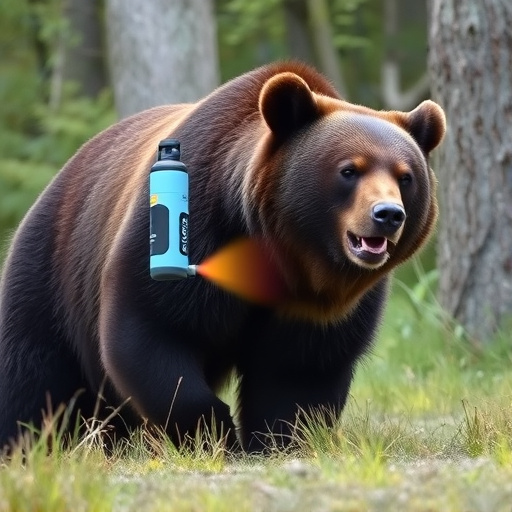Bear spray is a crucial defense tool for outdoor enthusiasts in bear-inhabited areas, effective against aggressive or defensive bears like grizzlies and black bears. Its optimal usage depends on recognizing warning signs of bear behavior and reacting quickly at close range (2-3 meters). Aiming for legs and belly, deploying quick bursts from a safe distance, and retreating is key. Following manufacturer instructions post-spraying ensures safety. After an incident, both the victim and bear need care, with legal considerations varying by region, emphasizing responsible use as a last resort alongside safe practices.
“Bearing the brunt of a bear encounter can be terrifying. Enter bear spray, a maximum strength defense weapon that offers crucial protection in the wilderness. This comprehensive guide explores what bear spray is, how it works, and its optimal deployment moments. Learn the proper usage techniques to ensure effectiveness during encounters. We’ll also delve into post-incident care and legal considerations, emphasizing the importance of knowing when to use bear spray properly.”
- Understanding Bear Spray: What It Is and How It Works
- When to Deploy Bear Spray: Recognizing the Right Moment
- Proper Usage Techniques for Maximum Effectiveness
- Post-Incident Care and Legal Considerations
Understanding Bear Spray: What It Is and How It Works
Bear spray, also known as bear repellent, is a powerful defense weapon designed to protect individuals from aggressive bears. It’s a crucial tool for outdoor enthusiasts navigating bear country. When deployed properly, bear spray creates a barrier of chemicals that temporarily incapacitates the bear, giving you time to escape or defend yourself.
Understanding how and when to use bear spray is essential for effective protection. The key lies in recognizing the appropriate situations to deploy it. Bear spray should be used as a last resort when faced with an imminent threat from a bear, typically during encounters where the bear displays defensive or aggressive behavior, such as charge, growling, or swatting. Proper usage involves aiming at the bear’s face and eyes, creating a cloud of spray to disrupt its sense of smell and vision, allowing for a safe escape.
When to Deploy Bear Spray: Recognizing the Right Moment
Knowing the right moment to deploy bear spray is crucial for effective self-defense. It’s designed for use when facing aggressive or defensive bears, such as grizzly or black bears, in close quarters. The key is recognizing warning signs of bear behavior—like huffing, jaw-popping, or stomping—and understanding the animal’s body language.
While curiosity and playfulness can sometimes masquerade as aggression, a bear spray should be used as a last resort when direct confrontation appears inevitable. Proximity plays a significant role; closer encounters require quicker decisions. In areas known for bear populations, carrying bear spray responsibly and learning proper usage techniques are essential measures to ensure safety during outdoor activities.
Proper Usage Techniques for Maximum Effectiveness
When to Use Bear Spray Properly: Maximizing Effectiveness
Bear spray, also known as bear repellent, is a powerful defense weapon designed to deter aggressive bears when faced with an encounter in their habitat. For maximum effectiveness, understanding the proper usage techniques is crucial. First and foremost, it’s essential to recognize that timing is key. Using bear spray appropriately requires you to be prepared and act swiftly when a bear approaches or shows signs of aggression. The ideal moment to deploy the spray is at close range, usually within 2-3 meters (6-10 feet), as this ensures the potent irritants will reach the bear’s eyes, nose, and mouth directly.
Proper usage involves aiming low, targeting the bear’s legs and belly, where spray can be more effectively absorbed. It’s also important to follow the manufacturer’s instructions regarding the amount of spray to use—typically a few bursts in quick succession. Additionally, maintaining a safe distance after spraying is vital; retreat slowly while keeping an eye on the bear to assess its reaction. Remember, the goal is to deter the bear and create enough time to escape, not to incapacitate it entirely. In the event of a surprise encounter or when cornered, promptly using bear spray can significantly increase your chances of escaping unharmed.
Post-Incident Care and Legal Considerations
After a bear spray incident, proper post-incident care is essential for both the victim and the bear. If the bear has been sprayed, it’s crucial to allow it to retreat and avoid any potential re-encounters. Seeking medical attention is vital for the individual who used the spray, as it can treat any injuries caused during the encounter and also provide a record of the incident.
Legally, understanding when and how to use bear spray is critical. Different regions have varying regulations regarding bear spray possession and usage. Always check local guidelines before venturing into bear country. Using bear spray responsibly involves assessing the threat level and ensuring it’s a last resort. When used properly, bear spray can deter aggressive bears and provide valuable time for escape, but it should be employed as a tool of last resort rather than a replacement for safe bear country practices.
Bear spray is a powerful tool for self-defense in bear country, but its effectiveness depends on proper usage techniques and understanding when to deploy it. By recognizing the right moment, using it according to expert guidelines, and following post-incident care instructions, individuals can maximize the protection offered by bear spray. Remember, knowledge and preparation are key to navigating potentially dangerous encounters with bears, ensuring your safety and peace of mind in these environments.
